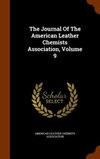Isolation and Identification of Moderately Halophilic Bacteria from Soak Liquor Samples Collected of Leather Tanneries
IF 0.5
4区 工程技术
Q4 CHEMISTRY, APPLIED
Journal of The American Leather Chemists Association
Pub Date : 2023-07-03
DOI:10.34314/jalca.v118i7.7857
引用次数: 0
Abstract
Isolation and identification of protease and lipase producing moderately halophilic bacteria from soak liquor samples and studying their adverse effects to the sheepskin using scanning electron microscopy may provide critical data on decomposition of raw hide/skin materials during soaking process. Moreover, enzyme-production properties of the moderately halophilic isolates (such as catalase, oxidase, lipase, protease, urease, caseinase, amylase, cellulase, pullulanase, xylanase) were determined. The effects of different NaCl concentrations, pH and temperature values on the growth of moderately halophilic bacterial isolates were tested. In the present study, four moderately halophilic bacterial isolates were isolated and selected for further experiments. The isolated species designated as SLMHB5, SLMHB10, SLMHB12, SLMHB13 were similar to Vibrio alginolyticus, Terribacillus halophilus, Vibrio alginolyticus, and Vibrio parahaemolyticus species, respectively. Scanning electron micrographs of sheepskin samples demonstrated that enzymatic activities of moderately halophilic bacteria isolated from soak liquor samples which decomposed the skin structure. After 35-days storage period, the sheepskin sample showed bad odor, sticky appearance and hair slip. Hence, it is recommended to control these microorganisms during the soaking process with an effective antimicrobial agent.从皮革制革厂采集的浸泡液样本中分离和鉴定中度嗜卤细菌
从浸泡液样本中分离和鉴定产生蛋白酶和脂肪酶的中度嗜卤细菌,并使用扫描电子显微镜研究它们对羊皮的不利影响,可提供有关浸泡过程中生皮/羊皮材料分解的关键数据。此外,还测定了中度嗜卤分离菌的产酶特性(如过氧化氢酶、氧化酶、脂肪酶、蛋白酶、脲酶、酪蛋白酶、淀粉酶、纤维素酶、纤维素酶、木聚糖酶)。测试了不同氯化钠浓度、pH 值和温度值对中度嗜卤细菌分离物生长的影响。本研究分离并选择了四种中度嗜卤细菌进行进一步实验。分离出的菌种被命名为 SLMHB5、SLMHB10、SLMHB12 和 SLMHB13,它们分别与藻溶弧菌、嗜卤特里巴氏菌、藻溶弧菌和副溶血性弧菌相似。羊皮样品的扫描电子显微照片显示,从浸泡液样品中分离出的中度嗜卤细菌具有分解羊皮结构的酶活性。贮存 35 天后,羊皮样品出现异味、外观发粘和毛发滑落。因此,建议在浸泡过程中使用有效的抗菌剂来控制这些微生物。
本文章由计算机程序翻译,如有差异,请以英文原文为准。
求助全文
约1分钟内获得全文
求助全文
来源期刊

Journal of The American Leather Chemists Association
工程技术-材料科学:纺织
CiteScore
1.30
自引率
33.30%
发文量
29
审稿时长
3 months
期刊介绍:
The Journal of the American Leather Chemists Association publishes manuscripts on all aspects of leather science, engineering, technology, and economics, and will consider related subjects that address concerns of the industry. Examples: hide/skin quality or utilization, leather production methods/equipment, tanning materials/leather chemicals, new and improved leathers, collagen studies, leather by-products, impacts of changes in leather products industries, process efficiency, sustainability, regulatory, safety, environmental, tannery waste management and industry economics.
 求助内容:
求助内容: 应助结果提醒方式:
应助结果提醒方式:


